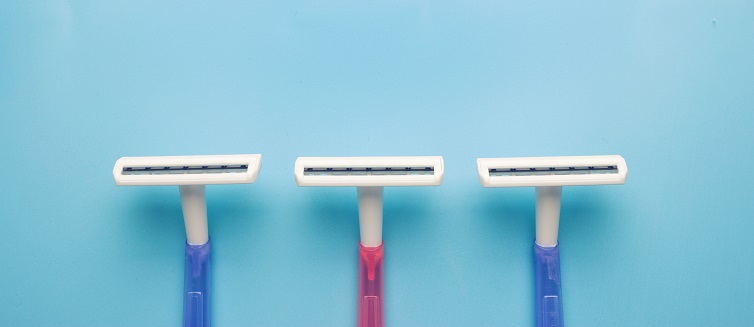If you have sensitive skin and shave, you have probably wondered at one time or another about how to get rid of razor bumps.
Razor bumps are also called pseudofolliculitis barbae. They are typically clusters of small, red, or dark bumps around hair follicles. They may develop heads and look like pimples. The surrounding skin often becomes red and inflamed, a condition people often refer to as razor burn.
Some people, like those with coarse or curly hair, are more likely to get razor bumps and burns. It is more common in men and usually occurs on the face, though it can happen anywhere you shave.
If you’re experiencing skin irritation or have pimples that appear after shaving for the first time, you should reach out to a dermatologist for a diagnosis.
Never Miss a Beat!
Subscribe to our family health newsletter
Thank you for subscribing!
You can now select the specific newsletters you'd like to receive.
You are already subscribed.
Subscribe to more newsletters in our email preference center.
Sorry, an error occurred. Please try again later.
Get Healthy Tips Sent to Your Phone!
What Is a Razor Bump?
Razor bumps, which can include ingrown hairs, are irritating bumps on the skin. They develop after shaving, waxing, plucking, and other hair removal techniques. Hairs curl back on themselves and grow into the skin.
In addition to causing skin irritation, razor bumps can lead to pimples and scarring.
What can cause razor bumps?
Your skin and hair type can make razor bumps more likely. They occur more often in people with curly hair.
How you shave can also play a role. Other causes of razor bumps include:
- Using an old razor.
- Using a dull razor.
- Shaving dry skin.
- Shaving against the direction your hair grows.
How to Prevent Razor Bumps
Other than having a genetic predisposition to razor bumps, other factors make an outbreak more likely. One of the most common causes is if the razor pulls and tugs at the hair during shaving. This pulling can break the hair under the skin, where it can grow and form bumps.
Learn what you can do to prevent this condition and what razor bump treatments you can try if it happens.
Clean the area
One of the best ways of preventing razor bumps is to wash the area with warm water and soap. You can also use a gentle scrub or shaving brush. This will remove oils and dirt that can clog pores.
Clean skin allows the razor to contact the skin to avoid tugging properly. Keeping your skin clean can also help you prevent skin infections like folliculitis.
Skin care
Paying attention to your skin can help you prevent razor bumps.
- Exfoliate your skin before shaving, using a brush, scrub, or chemicals to remove dead skin.
- Use a warm compress before shaving to help reduce the need for razor bumps treatment.
- Wet your skin before shaving to soften your hair and make shaving easier.
- Apply shaving cream or gel.
- Moisturize the area after shaving.
Keeping the skin hydrated before, during, and after will make shaving effortless to avoid the discomfort of razor bumps.
Razor maintenance and shaving technique
- Store your razor in a dry place; damp conditions can cause your razor to rust, leading to other skin infections.
- Make sure to replace razors frequently to ensure they’re sharp. A dull razor drags and tugs.
- Use a shaving brush to raise the hair for better contact.
- Shave in the direction of hair growth.
- Use short, quick strokes while shaving.
- Rinse your blade frequently while shaving.
- Shave often. As hair gets longer, it is more likely to re-enter the skin’s surface.
The final touch
After shaving, rinse the area with cold water to soothe the skin. Apply a fragrance-free balm. Don’t use any products that contain alcohol because they can irritate the skin.
Razor bumps can last from a few days to a few weeks before going away.
Treating Razor Bumps
Though red bumps after shaving can cause some discomfort, treating razor bumps isn’t usually expensive or complicated.
- Don’t shave: Stopping hair removal is the best method for treating or preventing razor bumps. However, for some, this is neither possible nor preferable.
- Moisturize your skin: Using a moisturizer after shaving can prevent razor bumps from forming or soothe any that appear.
- Try home remedies: Tea tree oil, a natural astringent, can help heal by drying out the bumps without damaging the surrounding skin. Aloe vera can help to soothe the skin and reduce redness.
- Use a cool compress: A cool compress can treat razor bumps when they occur. Chilled cucumbers applied to the skin can also reduce swelling.
- Use topical steroids: If the skin becomes itchy, hydrocortisone can also provide some relief.
With these tips, you won’t have to worry about uncomfortable razor bumps. For more information on preventing razor bumps or other skin conditions, contact the UPMC Department of Dermatology
Editor's Note: This article was originally published on , and was last reviewed on .
About Dermatology
The UPMC Department of Dermatology diagnoses, treats, and manages numerous hair, skin, and nail conditions and diseases. We care for common and uncommon conditions, and our treatments include both surgical and nonsurgical options. We operate several specialty centers for various conditions. The UPMC Cosmetic Surgery and Skin Health Center is a comprehensive dermatologic laser facility, offering a full range of cosmetic services and procedures. With UPMC Hillman Cancer Center, we offer a Skin Cancer Program that provides complete care from screenings, diagnosis, treatment, and beyond. Find a dermatology provider near you.
